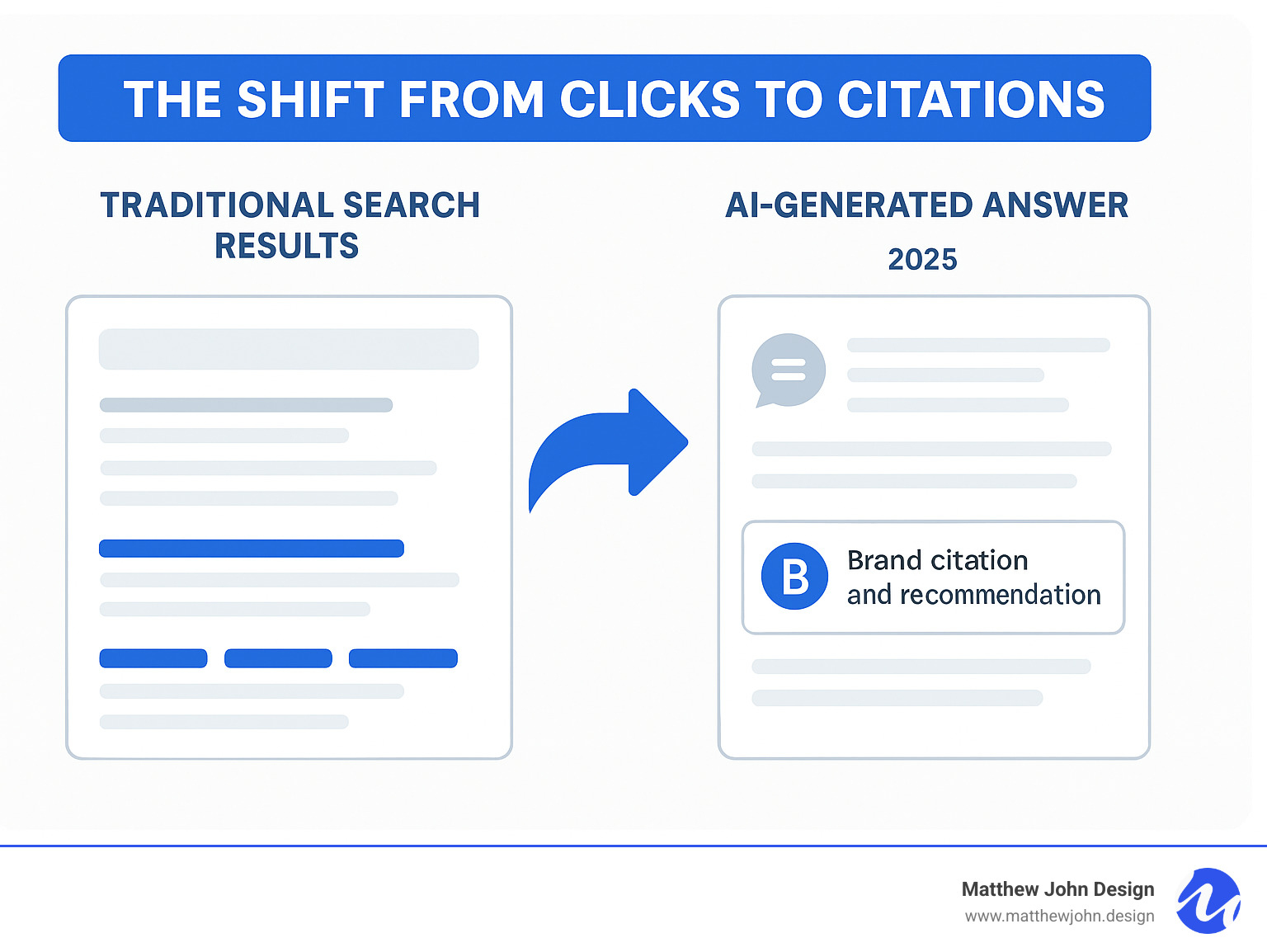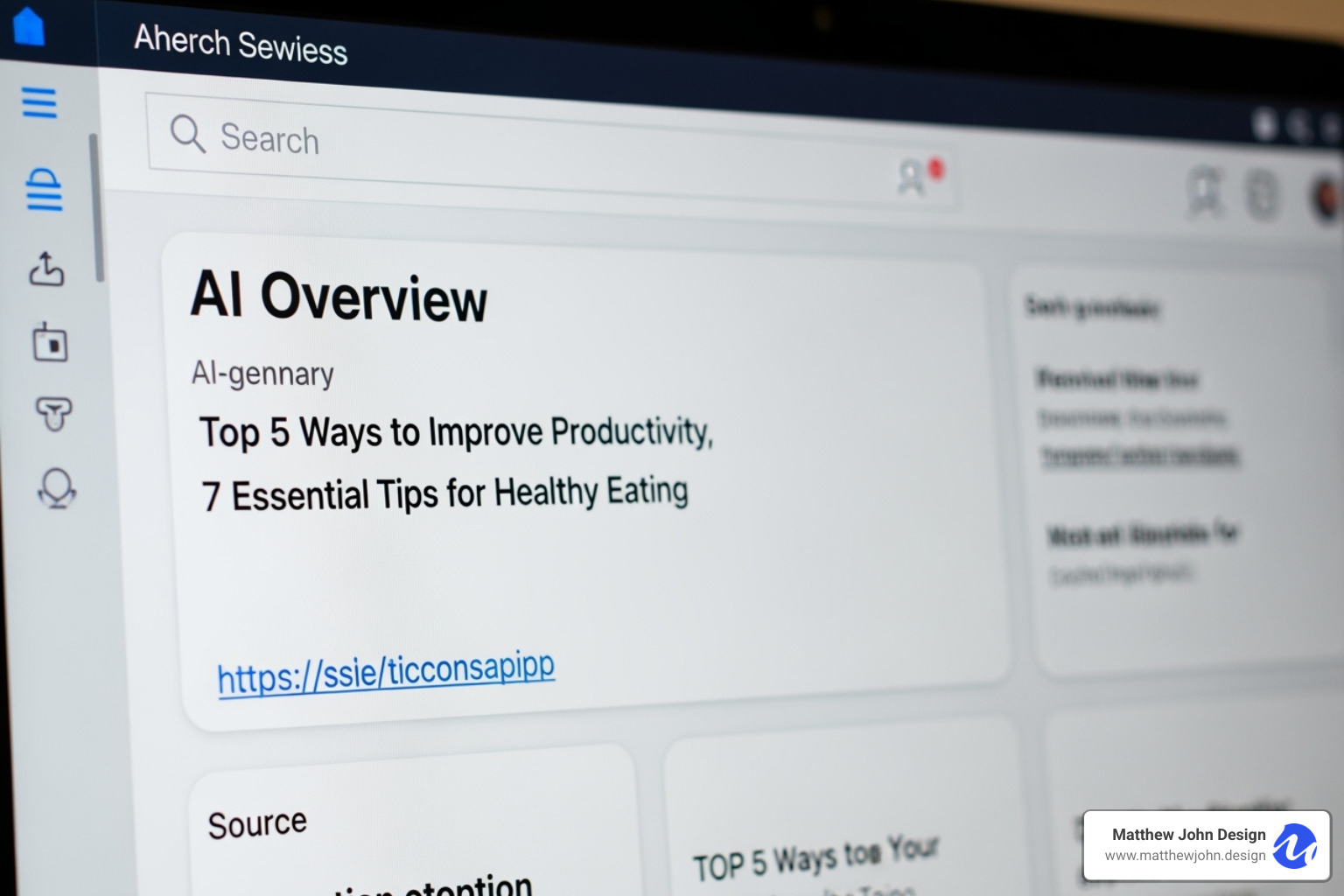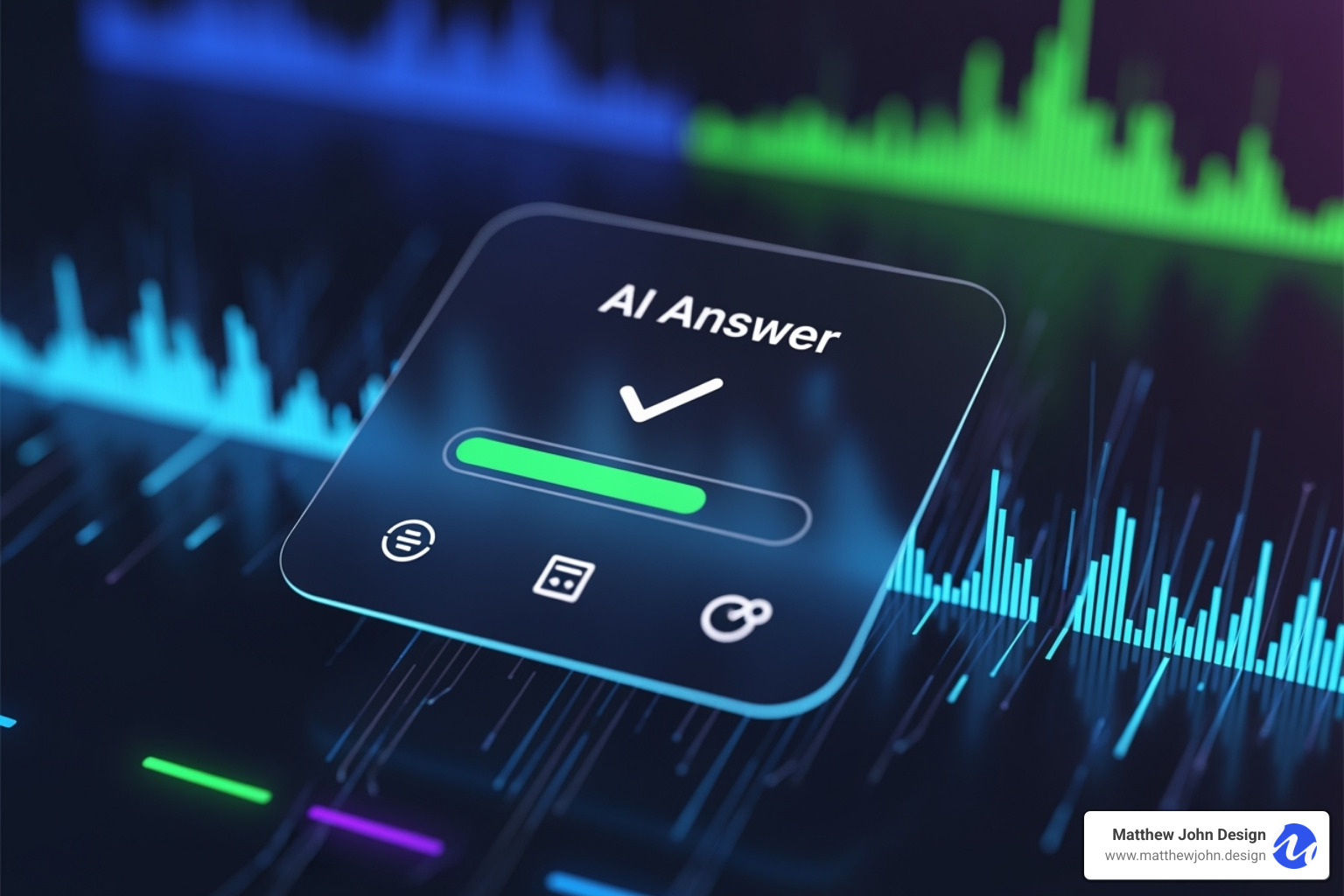Any information contained on this Website is not legal advice and should not be treated as such. You should always contact an attorney for help with your specific legal needs and issues. We may also earn a commission when you click links to our partners and purchase goods or services. For more information, read our Disclaimers Policy.
The Shift from Clicks to Citations
How to measure roi of answer engine optimization is a critical question as AI transforms online search. Instead of clicking through search results, users now get direct answers from AI engines like ChatGPT, Google AI Overviews, and Perplexity.
To measure AEO ROI effectively, you must track three key areas:
- Visibility Metrics - Brand mentions, citation frequency, and share of answers.
- Engagement Metrics - Post-citation traffic quality and conversion performance.
- Revenue Attribution - Connecting AI traffic to business outcomes using UTMs and GA4.
The numbers are compelling. One in ten U.S. internet users now use generative AI for search first. AI Overviews appear in 16% of Google desktop searches. Crucially, LLM traffic often converts at higher rates than traditional organic search; for example, some eCommerce sites report conversion rates of 5.53% from AI traffic, compared to 3.7% from regular search.
This shift means your brand must optimize for citations, not just clicks. When AI answers a query like "What's the best project management software?", it mentions specific brands. Inclusion in these responses builds awareness and credibility, influencing future buying decisions even without clicks.
The challenge is measuring this new visibility. Traditional SEO metrics like rankings and CTR are insufficient. AEO requires new approaches to track brand mentions, measure referral traffic quality, and attribute revenue to AI visibility.

Key Metrics for Measuring AEO Performance
Measuring the ROI of Answer Engine Optimization (AEO) requires tracking citations within AI responses, a major shift from traditional SEO's focus on clicks. Unlike stable search rankings, AI platforms like ChatGPT and Google AI Overviews generate unique, probabilistic answers that may not include links. Success depends on tracking brand appearances, user engagement, and business results. Your AEO measurement strategy must cover three core areas: visibility, engagement, and conversion metrics.

How to Measure the ROI of Answer Engine Optimization: Visibility Metrics
Visibility is the foundation of AEO success. Instead of aiming for top rankings, AEO is about becoming the answer AI engines cite.
Share of Answer is your most critical visibility metric. It measures how often your brand appears in AI responses for relevant queries. For example, Bank of America captures 32.2% of banking-related mentions, a substantial mindshare.
Brand mentions track the frequency of your brand appearing in AI responses. These mentions build awareness for future purchases, even without clicks.
Citation frequency reveals which content AI engines value most. Consistent references to your content signal authority and show what resonates with AI.
Sentiment analysis adds context to mentions. Positive citations have a different impact than negative or neutral ones, helping you gauge reputation within AI responses.
Benchmarking against competitors provides context for your performance. Early adopters are dominating, so establishing monitoring systems now is key to gaining an edge.
For comprehensive AEO monitoring with tools and analytics offered by Matthew John Design, specialized tracking systems can monitor brand visibility, track share of voice, and provide competitive analysis.
Engagement Metrics: Analyzing Post-Citation Behavior
When users arrive from AI citations, the traffic quality often exceeds that of traditional organic search. Understanding this behavior reveals the value of your AEO efforts.
Traffic quality from AI platforms is impressive. Visitors are often more qualified, leading to higher conversion rates; some eCommerce sites have reported LLM conversion rates as high as 5.53%, compared to 3.7% from organic search.
Bounce rate for AI-referred traffic is often lower, suggesting AI effectively pre-qualifies users by matching them with relevant content.
Time on site is frequently longer for AI-referred visitors, indicating the AI successfully matched their query with your valuable content.
Pages per session data reveals if visitors explore beyond their landing page. Higher numbers suggest successful user journeys and effective internal linking.
These engagement patterns connect to broader Conversion Rate Optimization strategies, helping you maximize AEO visibility.
Conversion Metrics: Connecting AEO to Bottom-Line Results
Connecting AEO to revenue requires sophisticated attribution tracking. Customer journeys are complex; a user might see your brand in an AI answer and convert later through another channel.
UTM parameters help track AI-generated traffic and conversions in your analytics when trackable links are available.
Google Analytics 4 is ideal for AEO attribution with its event-based model. You'll need to set up ecommerce events in GA4 to properly track conversions.
GA4's attribution paths report shows how AEO contributes to the conversion funnel, even when it's not the final touchpoint.
Lead value and Customer Lifetime Value calculations are essential for businesses without direct online sales. If your average customer LTV is $10,000 and 25% of leads convert, each lead is worth $2,500. This framework quantifies the monetary impact of AEO.
The attribution challenge is complex, but establishing measurement systems now provides a significant advantage. For guidance on Optimizing Webflow sites for conversions, comprehensive strategies can maximize your AEO ROI.
How to Measure the ROI of Answer Engine Optimization: A Step-by-Step Framework
Let's walk through the practical steps for calculating AEO ROI. This involves tracking investments, attributing revenue, and applying a clear formula.
Step 1: Calculate Your Total AEO Investment
Calculating ROI starts with knowing your costs. While AEO investments may overlap with SEO, you must account for resources dedicated specifically to answer engines.
Your total AEO investment includes:
- Content Creation Costs: The cost of producing AEO-optimized content, including salaries for writers or fees for agencies. Investing in AI-Driven SEO Content Creation can streamline this.
- Technical SEO Costs: Investments to ensure your site is technically sound for AI crawlers, like server-side rendering and schema.
- AEO Tools: Subscription costs for monitoring, analytics, and content tools.
- Agency Fees: Retainers or project fees for AEO services (typically $2,501-$5,000 per project in the U.S.).
- In-house Team Costs: Salaries and benefits for dedicated AEO specialists.
A comprehensive AEO budget is often similar to SEO, typically $2,500-$7,500 per month.
Step 2: Attribute Revenue and Define Conversion Value
Attributing revenue is tricky, as AEO's impact is often indirect.
- Assisted Conversions: AEO often assists conversions. A user may find you via an AI answer and convert later. Use GA4’s Attribution paths report to credit AEO for its role.
- Multi-Touch Attribution: Move beyond last-click models. Use data-driven attribution in GA4 or other tools to distribute credit across all touchpoints, including AEO.
- Self-Reported Attribution: Add a "How did you hear about us?" field to forms. This qualitative data provides direct insight into AEO's influence.
- Disconnected Tech Stack Challenge: Siloed analytics, CRM, and sales data make it hard to connect visibility to revenue. Integrated data systems are crucial for accurate ROI measurement. For robust Revenue tracking solutions from Matthew John Design, we emphasize integrated data strategies.
By attributing revenue, you can assign monetary value to AEO-influenced conversions. For example, if your LTV is $1,000 and 10% of leads convert, each lead is worth $100.
Step 3: Apply the AEO ROI Formula and Overcome Challenges
With your total investment and attributed revenue, apply the standard ROI formula:
AEO ROI = (Revenue from AEO - AEO Investment) / AEO Investment * 100%
For example, a $10,000 investment that generates $50,000 in attributed revenue yields a 400% ROI.
Challenges in Measuring AEO ROI:
- Forecasting Potential ROI: Forecast AEO ROI by analyzing search volume, estimating share of answers, and projecting traffic and conversions based on historical data. This helps set realistic expectations.
- Citation Volatility: LLM answers are volatile, with monthly citation change rates often exceeding 40-50% on platforms like Google AI Overviews and ChatGPT. This requires continuous optimization to maintain visibility.
- Time Lag: Like SEO, AEO takes time (often 3-6 months) to show results. AI models need time to update, so measuring ROI too early can be misleading.
Despite these challenges, tracking AEO ROI allows for data-driven decisions and demonstrates tangible value to stakeholders.
Best Practices for Improving AEO Visibility and ROI
Measuring AEO ROI is easier when you're actually getting cited. Optimizing for visibility is crucial for improving your return. Think of AEO as building a strong, accessible bridge between your expertise and AI engines to drive meaningful returns.

Technical and On-Page Optimization for AI Crawlers
AI engines need clean, accessible content. Think of technical optimization as rolling out the red carpet for AI crawlers.
Raw HTML and server-side rendering are foundational. AI models prefer raw HTML over JavaScript-dependent content, which they often can't execute. Server-side rendering is essential for visibility, especially on platforms like Webflow.
Schema markup using JSON-LD acts as a translator for AI engines. Use schema like Product, FAQ, and How-to to help them understand and accurately cite your content.
Semantic HTML structure with elements like <article> and a logical header hierarchy (H1, H2, H3) improves "chunking," helping AI extract meaning from content blocks.
Page speed optimization is critical, as AI crawlers have limited time budgets. Also, include content freshness signals like modification dates, as LLMs favor recent content.
For technical sites, allowing AI crawlers through llms.txt files and publishing document indexes can increase crawl rates by 5-10x. Our Webflow SEO Settings Best Practices guide covers many of these fundamentals.
How to Measure the ROI of Answer Engine Optimization: Content Strategy
Creating content for AI citation requires a different approach than traditional SEO.
Building citable authority means becoming the go-to source for AI by demonstrating genuine E-E-A-T (Expertise, Experience, Authoritativeness, Trustworthiness). Surface-level content is ineffective.
Listicles dominate AI citations. According to research, listicles make up 32% of all citations. LLMs prefer their structured, scannable format.
Content freshness is critical. Add the current year to titles and metas. Most citations occur within 2-3 days of publishing and then decay, so consistent publishing is key.
Semantic chunking is vital. LLMs cite answers, not articles. Dedicate each paragraph to a single idea to increase citation chances.
Original research and data provide the unique, authoritative content AI engines seek as primary sources. This also creates repurposable assets.
Optimizing for snippets requires front-loading value propositions. Google's AI overviews analyze short text blocks (around 160 characters), so write complete, context-rich sentences with key info at the start.
For deeper insights, explore our guide on How Semantic SEO Impacts Content Creation.
Cross-Channel Presence and Local AEO
Your website is just one piece of the AEO puzzle. AI engines pull information from the entire web.
User-generated content platforms like Reddit, YouTube, and Quora are citation goldmines. YouTube earns 18.8% of Google AI Overview citations. Engage authentically, as AI can detect promotional content.
Cross-posting your core content creates "signal amplification." When LLMs see the same high-quality content on your blog and LinkedIn, they're more likely to cite it.
Local SEO for AI Mode is important even for national brands. Google's AI prioritizes local business information, so maintain a comprehensive Google Business Profile with quality photos and reviews.
Building an authoritative brand requires a holistic approach with digital PR and community engagement. This multi-platform authority building supports your Content Marketing for SEO and improves citation potential.
These best practices create a virtuous cycle: better optimization leads to more citations, driving higher-quality traffic and improving ROI.
Frequently Asked Questions about Measuring AEO ROI
Navigating how to measure roi of answer engine optimization can feel overwhelming. Let's address the most common questions about this evolving landscape.
What is a "good" ROI for AEO?
A "good" AEO ROI isn't as straightforward as for traditional SEO (where 5x is healthy). AEO operates differently, so expectations should adjust. The key is higher conversion rates. AI traffic can convert at much higher rates (e.g., some eCommerce sites report conversion rates of 5.53% from AI traffic versus 3.7% from organic), meaning you can achieve substantial ROI with less traffic.
Brand visibility growth is another valuable, though harder to quantify, return. Consistent appearance in AI answers builds credibility and authority, making future customer acquisition more efficient. Think of AEO as a long-term value play. Establishing authority in AI training data now creates compounding advantages as AI search adoption grows. A "good" ROI is one that contributes meaningfully to your business goals.
How long does it take to see AEO results?
Patience is key. AEO follows a timeline similar to traditional SEO: initial progress may appear in weeks, but measurable ROI takes longer. Building authority takes time and consistent effort in content creation, technical optimization, and cross-platform presence.
Citation volatility is high, with monthly change rates often over 40%. This requires ongoing optimization but also creates opportunities for agile brands. Furthermore, the rapid citation decay pattern is crucial; most citations occur within days of publishing and then drop off, highlighting the need for content freshness and consistent publishing. While you may see quick mentions, demonstrating clear ROI requires persistence.
Can I use traditional SEO tools to measure AEO?
Your existing SEO toolkit provides a foundation but is incomplete for AEO. They offer valuable insights but weren't designed to measure AI citation performance.
Google Analytics 4 is essential for tracking AI-referred traffic using UTMs and monitoring engagement. Google Search Console helps you understand the impact of AI Overviews on traditional search performance. However, these tools miss crucial AEO metrics like share of answers, sentiment of mentions, and competitive intelligence.
These specialized insights require purpose-built solutions. The market for specialized AEO tracking tools is maturing, with emerging platforms that measure share of voice and track visibility across AI engines. For comprehensive AEO tracking, Matthew John Design offers specialized services to bridge the gap between your existing analytics and the insights needed to optimize your AEO strategy.
Conclusion: Future-Proofing Your Brand in the Age of AI
Search has fundamentally changed. We've moved from a click-based world to one where AI citations determine brand visibility. How to measure roi of answer engine optimization is no longer optional—it's critical for staying competitive.
The good news is that measuring AEO ROI is achievable. By tracking visibility, engagement, and conversion metrics with proper attribution, you can clearly see how your efforts are performing.
The challenge is that time is short. Competitors are already establishing authority with AI engines. Delaying makes it harder and more expensive to gain visibility.
Consider the future of search: AI agents will not just answer questions but research and recommend options independently. Being the brand AI cites will be your lifeline to new customers. Brands investing in AEO today are building compounding advantages. They will be the trusted recommendations of AI, while those who wait risk becoming invisible.
Measuring AEO ROI starts with action. You can't optimize what you don't track. The framework we've outlined provides the tools to quantify your success and make data-driven decisions.
Ready to future-proof your brand for the age of AI search? The team at Matthew John Design specializes in creating AEO-optimized content strategies that get results. We'll help you build authority, create content, and set up the tracking systems you need to dominate AI search. Get expert help with your AEO content strategy and secure your place in the AI-powered future.

.jpg)